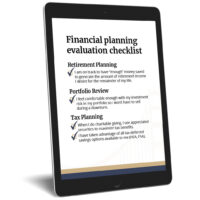
To lower your tax bill, avoid these 9 common tax-planning mistakes
If you think your tax bill is too high, you’re not alone. Two-thirds of Americans feel like they spend too much on federal taxes—and that’s before tacking on property or state taxes.
What if you could avoid some of the pains of tax season? From tax-deferred investing to charitable deductions and income deferrals, Americans have a wealth of options to lower their tax burdens. Whether you’re not getting the most from these strategies, or failing to use them at all, you could be costing yourself money.
Read on to learn about nine common tax planning mistakes, and how you can avoid them. Keep in mind that while this article provides tax guidance for planning purposes, it is not meant to replace formal tax advice from your tax professional.
Effective tax planning is a year-round venture
Cutting a large check to the IRS is never fun. The frustration often leads to resolutions about finding ways to save next year. But as tax season fades further into the rear view mirror, many people neglect to follow up, and the cycle repeats itself every April.
Just as you wouldn’t avoid an oil change right up until your engine dies, you shouldn’t ignore taxes until the bill is due. The key to optimizing your tax burden isn’t just “finding a better strategy for next year”. You need to make taxes an ongoing component of your financial planning.
Don’t make these 9 common tax-planning mistakes
Treating tax planning as a seasonal activity is the biggest error you can make. But here are nine other common mistakes that could be inflating your tax bill.
1. Deferring or accelerating income at the wrong time
The ability to defer or accelerate income is a valuable tool to manage your tax burden. But to realize its full potential, you need to plan carefully—often for multiple years in advance.
For example, let’s say you have a large bonus check coming your way or a new client contract going into effect that will have significant income along with it. Depending on your situation, it may make sense to make choices about the timing of when to sell certain investments if they push you into a higher income tax bracket. Deferring (or accelerating) income can be especially valuable if you choose to take a sabbatical or midlife gap year. A year of little or no income offers a chance to recognize capital gains or exercise stock options, while keeping your tax bill low.
2. Missing out on tax-deferred savings
Investing in retirement accounts is a great way to reduce taxable income—not to mention securing your financial future. Yet many people fail to take full advantage of the opportunity. To avoid this common mistake, make sure you’re making the most of tax-deferred retirement accounts, such as:
- Traditional IRAs
- Employer-sponsored plans like 401(k)s, 403(b)s, and 457s
- Simplified Employee Pension (SEP) Plans and SIMPLE IRAs, if you’re self-employed
- Health Savings Accounts (HSA)
Most people can contribute to at least two of these accounts, and some have the chance to use all four. If applicable, make the maximum contribution to accounts with employee-matching programs, such as 401(k)s, first. Then, fund individual accounts as close to the annual limit as you can.
If you’re using an HSA, make sure you’re maximizing their triple tax benefit—contributions, growth, and withdrawals are all tax-free. If you can, pay for health care during your working years with post-tax money and fund your HSA to the maximum. Then, use the tax-free earnings to pay for health care as you get older.
3. Not planning for distributions in retirement
Accumulating wealth is critical for a comfortable and secure retirement. But it’s only half of the process—you also need a plan for efficient use of your savings.
Roth conversions are a popular strategy for high earners to optimize distributions. Even when your income surpasses the limit to qualify for making Roth IRA contributions, the IRS does allow you to contribute after-tax dollars to a Traditional IRA. Once you make this contribution up to the IRS limit, you have the option to convert that Traditional IRA money to a Roth IRA.
This strategy is often referred to as employing the “backdoor Roth IRA” method since the earner is not able to “go through the front door” and contribute directly to a Roth IRA. Keep in mind, you’ll have to pay tax on any earnings. However, the distributions will be tax-free in retirement. The following circumstances are ideal for a Roth conversion:
- When your income in a given year is lower than usual, take advantage of your current, lower tax bracket to reduce the amount you’ll pay on the conversion.
- During stock market drops, to reduce the amount you pay on converted savings. Move the money when the market is low, then allow it to grow in your Roth IRA.
Please note that this is a simplified explanation of how a Roth IRA conversion works. Among other missteps, you need to be careful about commingling before and after-tax funds in a Traditional IRA. Advanced strategies like utilizing a Backdoor Roth IRA method are best executed with professional guidance to avoid costly mistakes.
4. Forgetting to track capital improvements to your home
Any home renovation project which substantially alters or repairs the structure qualifies* as a capital improvement. By adding the project’s cost to your home’s basis, you reduce future capital gains tax liabilities. This calculation is based on the difference between the selling price and the adjusted basis of your home at the time of sale.
If you have a disability or care for aging parents, you can also deduct any home renovations made for medical purposes. Some examples of medically necessary renovations include:
- Widening doorways or halls and adding ramps for assistive-device access
- Handrails, railings, and support bars in bathrooms or other hazardous areas
- Installing stairway lifts
For tax purposes, you’ll need to keep detailed documentation of all renovations.
*To review a complete list of what qualifies to add to your basis, see IRS Publication 523.
5. Failing to claim all available deductions
As the tax code has evolved to increase the standard deduction, itemizing has become less advantageous. However, it can still work in your favor if you group your deductions into a single year. Consider the following situations where “bunching” deductions can make itemizing attractive:
- Charitable giving: Rather than donating smaller amounts annually, give larger amounts every two or three years. Donating appreciated stock or securities can also be a good strategy, as you can write off the market value and avoid capital gains tax.
- Medical expenses: If you have a major procedure on the horizon that’s not urgent, consider postponing it to the following year. You’ll have all of the medical expenses in one tax year, and it can optimize your health insurance usage, too.
- Business equipment: If you’re self-employed or own a business, plan large purchases carefully to optimize your Section 179 deductions for a given year.
6. Overlooking tax-loss harvesting opportunities
While everyone loves to see their portfolio in growth mode, markets don’t always go up. Thankfully, even a down year can have its advantages.
When you sell an investment for less than you paid, known as a capital loss, you can use the difference to offset capital gains. Known as tax-loss harvesting, this strategy allows you to squeeze value from underperforming stocks. You can offset short- or long-term capital gains with capital losses that are the same type; however, you cannot mix and match short-term and long-term gains and losses. While you are only allowed to deduct $3,000 of losses per year (that you are unable to offset with gains), you can roll excess losses into future years.
7. Not taking “asset location” into account
You may often hear about rebalancing your portfolio as a necessary step to balance risk and return. But you also need to consider your ratio of taxable versus tax-deferred accounts–and the types of assets in those accounts—as you prepare for retirement.
Aside from investing in the right mix of fixed income, cash and equities, you also need to take “asset location” into account to gain maximum tax advantage. This means making sure that the securities you hold are in the most advantageous types of accounts for your circumstances.
For example, you may want to hold less tax efficient investments such as high yield bond funds or zero coupon bonds in a tax-deferred account. Depending on your situation, you may choose to hold equities in a taxable account so you can benefit from the lower capital gains rates and the lower taxes on dividends. Muni bonds can also provide more tax benefit in a taxable account since they are not taxed at the Federal level and can be tax-exempt in some states.
8. Underutilizing education savings plans
529 plans are a popular way to save for educational costs, since investments grow on a tax-deferred basis. And withdrawals for qualified education expenses are exempt from both federal and state taxes. Since K-12 expenses (up to $10,000 per year) qualify, as well as college and post-graduate degrees, there’s ample opportunity to use funds in a 529 account.
Thanks to the SECURE 2.0 Act, beneficiaries have a bit more flexibility with 529 plans. As long as a plan has been open for at least 15 years, you can roll unused funds (up to a $35,000 maximum amount per beneficiary) into a Roth IRA. In any given year, you may only rollover an amount equal to the annual Roth IRA contribution limit. Alternatively, you can transfer leftover money into another family member’s 529 plan. Keep in mind, if you take a withdrawal for non-qualified expenses, you’ll incur taxes, plus a 10% penalty.
9. Ignoring estate planning
If you’re a parent, you’re not only striving to secure your own financial future—you’re also working to set your children up for success. The sooner you consider the tax implications of your legacy, the more flexibility you have.
High-net-worth individuals will often set up trusts (such as irrevocable life insurance trusts, grantor-retained annuity trusts, and dynasty trusts) to help minimize tax exposure and provide for future generations. Another strategy to reduce the taxable estate is by taking advantage of the annual gift tax exclusion. For 2024, the IRS allows individuals to gift up to $18,000 per year, per recipient without incurring any gift tax (or $36,000 for couples).
We recommend all families and individuals to begin estate planning early—such as in midlife—especially if you’ll be leaving a significant estate behind. Keeping pace with the ever-changing tax law, and, if necessary, enlisting a professional to help, will minimize the impact of taxes on your trust.
Managing your financial future
Optimizing your tax burden is just one piece of your financial puzzle. Meeting your financial goals requires ongoing maintenance—from saving actively to protecting and positioning your assets to meet your financial goals.
Our financial preparation checklist can help you make sure you’re on track. No two individuals have precisely the same needs, but covering these basics will guide you towards a secure future. And your financial situation isn’t static—which is why you need to check-in periodically. Working with a financial planner is a great way to stay on top of your financial goals, including tax planning, throughout the year.
The information provided herein is for informative and educational purposes only. The use of hyperlinks to third party websites is not an endorsement of the third party. Third party content has not been independently verified. To understand how this content may apply to you, please contact a financial advisor.






